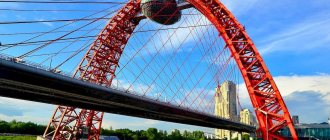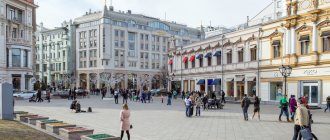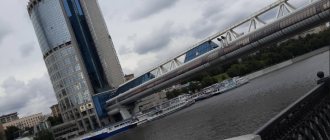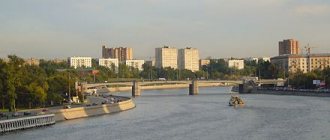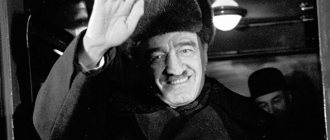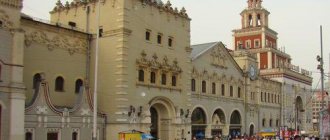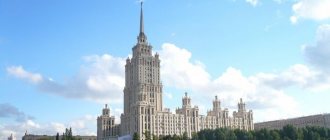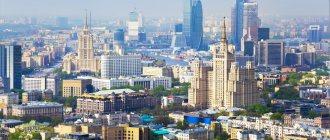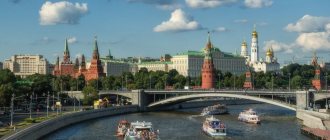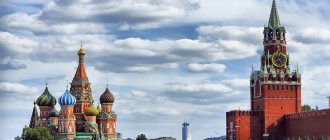One of the oldest, most popular and beautiful objects in St. Petersburg is the Troitsky drawbridge (formerly Kirovsky). Its openwork cast-iron spans have great artistic value. The massiveness of the imperial style creates a unique look. This is the 3rd largest and most important of the main crossings in St. Petersburg.
Until 1965, it was recognized as the longest in the city. It is used as a pedestrian, automobile, and tram route. The Kirov Bridge in St. Petersburg attracts tourists and is considered almost a “bread card” for artists.
History of Trinity Bridge
The first Trinity Bridge was built in 1803. It was located higher upstream than the modern one. The first option was a floating one - a pontoon, i.e. had pontoon supports. Now this type is used to support cranes and other heavy equipment for working on water.
It was originally made of wood and was built in the spring and summer. In winter, the townspeople crossed the river on ice. They established a crossing just opposite the Summer Garden, which is a little higher along the Neva, and called it Petersburg. Served the city for 20 years.
In 1824, the need arose to build a new bridge, since the old one had already begun to deteriorate. It was then that it was moved lower and it began to connect the 1st Admiralty and Petrograd Islands, through Troitskaya and Suvorovskaya Squares. The reconstruction, at that time still a floating bridge, was completed according to the designs of P. Bazen, V. Lebedev and A. Zuev in 1827.
Initially they wanted to call it Suvorovsky, since the Field of Mars is located very close, and there is a monument to the commander on it. But they changed their minds and the crossing received a name in honor of the nearby Trinity Square. It was operated for about 70 years.
In 1934, the First Secretary of the Leningrad Regional Committee, Sergei Mironovich Kirov, died, and in his memory the bridge was renamed Kirovsky.
And in 1897, another thorough reconstruction began, which lasted until 1903. During this period, the Trinity Bridge in St. Petersburg became permanent. An international competition was announced, the number of projects reached 16. Later, another tender was held, which was won by the French company. There were several other options, but the Duma chose the Batignolles company, which was managed by E.G. Eiffel. He proposed a design for an arch system bridge.
The construction of the permanent bridge cost more than 5 million. There was a special clause in the contract that stated that only Russian workers would build the Trinity Bridge and Russian materials would be used. The project was approved by Nicholas II - June 5, 1897.
It is then that the crossing becomes steel. The regularly flooded earth dam is demolished, expanded and a granite embankment is created. And the Trinity Bridge in St. Petersburg takes on a familiar appearance and name.
The opening of the bridge was planned to coincide with the wedding anniversary of the imperial couple, but it was not completed in a timely manner. The construction company paid a huge fine and the bridge opened on the 200th anniversary of St. Petersburg.
Temporary stands and a tent were erected for the President of France and the Emperor so that guests of Northern Palmyra could fully enjoy the spectacle of the religious procession and subsequent fireworks. For a long time, local newspapers called the Trinity Bridge a Russian-French symbol of friendship.
People were greatly impressed by the fact that the first lift of the bridge was carried out by simply pressing a button, which was carried out by the Emperor of Russia.
In 2001, a major restoration of the span began, with the closure of the crossing. The entire architectural part of the grilles, lighting poles, obelisks, etc. was restored. The bridge was repainted. Many internal parts have undergone radical replacement and modernization. In addition, the original symbols of imperial power (crown and double-headed eagle) were returned to him. Some support parts, granite cladding and much more were also replaced.
If you are interested in the bridges of St. Petersburg, then read about the Kokushkin Bridge.
Bridges leading to the Kremlin
The first stone bridges appeared in Moscow with the construction of the current Kremlin walls, at the turn of the 15th - 16th centuries. In those years, the Kremlin was equal to Moscow, it was the city itself, and the bridges corresponded to the city gates. Three gates looked towards Red Square, two towards the Neglinnaya side and one towards the Moskva River. The bridges on Red Square were thrown over a moat that connected the Moscow River and the Neglinnaya River and turned the Kremlin into an island. From those times, only the Trinity Bridge across Neglinnaya has survived, despite the fact that Neglinnaya itself is hidden underground. The thirteen-span Trinity Bridge, now the main pedestrian route to and from the Kremlin, dates back to 1516. Of course, it was rebuilt several times, especially radically in 1901. Initially, the bridge consisted of only external walls, on which a deck was laid without the support of arches. The vaults appeared only in the 18th century. Now the spans of the bridge, except for one, are blocked, which impoverishes its appearance. On the Arbat, Zaneglinskaya side of the bridge, the famous Kutafya Tower has been preserved - a bridgehead fortification, a diversion archer, which should be considered part of the bridge.
The same bridgehead towers existed at the Konstantino-Eleninsky Gate on Vasilyevsky Spusk (now half-buried) and at the Tainitsky Gate on the side of the Moscow River. In the latter case, the bridge did not cross the river (even the Italian engineers of Ivan III and Vasily III did not dare to do this), but over the second, unpreserved line of walls.
With the expansion of the city, that is, with the construction of the Kitai-Gorod wall in the 1530s, the number of Moscow bridges doubled: Kitai-Gorod was also surrounded by a moat. The most famous is the Voskresensky Bridge across Neglinnaya, which leads to the gate of the same name, to Red Square from Tverskaya Street. Its remains, the supporting parts, excavated in the 1990s, became the main exhibit of the underground Archaeological Museum. The bridge, of course, is not the first on this site; it dates back to 1601-03, the time of Boris Godunov. If you believe the chronicle, the parapets of the bridge ended with battlements, like the neighboring Trinity, but if you believe the first drawn plans of Moscow, completed in the same years, then with arched walls without a roof.
The stone bridge across the Moscow River became the concern of the first Romanovs. To do this, in 1643, the government of Tsar Mikhail Fedorovich invited “chamber masters” the Christlers, uncle and nephew, from Strasbourg. They managed to make a model and an estimate, but soon the king and one of the masters died. The project was resumed only in 1682 on the initiative of Prince Vasily Golitsyn, who headed the government of Princess Sophia. Construction took five years. It is believed that the work was supervised by a certain elder monk Philaret. The choice of location - not in connection with Red Square, but in connection with Borovitskaya - seemed to return the central importance to this latter (this is where Moscow began), and also emphasized the role of Kyiv and the Kyiv road (Yakimanka) in the political history of those years. The eight-span Bolshoi Kamenny (All Saints) Bridge, remembered by many images, existed until 1855, and its successor until the 1930s. On the left, Kremlin bank, the bridge approached Lenivka Street. The current bridge has moved lower along the river, going directly to Borovitskaya Square (it is interesting to note that the House on the Embankment was built along the old red line). Lenivka passed through the All Saints Gate of the White City, which disappeared in the 18th century: the old bridge led to them. At the same time, the bridgehead tower on the Zamoskvoretsk side of the bridge, the famous Six Gates, disappeared. In addition to six gateways, it had several pyramidal tiers, correlated with the tiers of the Borovitskaya tower of the Kremlin, and two crowning tents.
How it's made, appearance
The bridge is beautiful, elegant and large, but it has a complex design. The most interesting is the 5th span. Visually, the spans are similar to arched through trusses. In fact, it is a combination of cantilever-arch and cantilever-beam trusses.
The largest span is medium, 96 m. It has arched, riveted, lattice trusses that protrude forward and balance lateral pressure.
The bridge is raised on the left bank using an electromechanical or manual drive. Opens to a maximum width at an angle of 72º. The flight is single-winged. The railing has granite parapets and obelisks on the side of the square.
The right bank is connected by a stone arcade, its length is 79.88 m.
The Trinity Bridge is illuminated by 16 candelabra, which, in turn, have 3 shades. Additionally there are 24 small candelabra.
The bridge's grille and lanterns were designed by architects R. Patouliard and V. Chabrol in the French Art Nouveau style.
If you enter the bridge from the Campus Martius, you can see 2 rostral obelisk columns. Memorial plaques are located on the pedestals. They are dedicated to the people who stood on the bridge and other events associated with this landmark.
The roadway and sidewalk are delimited by a curb, 50 m high. There is a dividing strip along the axis. Thanks to granite platforms, it is possible to go down to the water.
Find excursions in St. Petersburg >>
Wiring schedule
Tourists should remember that the Trinity Bridge in St. Petersburg is a drawbridge. Divorce starts from April 10th until November 30th.
Carried out at night from 1.20 to 4.50 am.
The first time the Trinity Bridge was erected was by Nicholas II in 1903. At that time, the adjustable mechanism was very different from the current one and the wing moved horizontally, opening the passage for ships.
We moved to Antalya. We tell you everything in detail in our group. in contact with: https://vk.com/antalya2. Also watch our videos at YouTube:
Nowadays, this structure is unique in that it has only one wing, which opens the skylight for navigation. Now the wiring is carried out thanks to a hydraulic drive and a counterweight weighing 1450 tons. It takes only 6 minutes for the mechanisms to raise the wing 70 degrees.
Where is the best place to watch the rise of the Trinity Bridge?
Near the Winter Palace is a better place for viewing. Of course, you can see it from the spit of Vasilyevsky Island, but it will be visible in the distance. Many tourists stop right on the Palace and Petropavlovskaya embankments, but in the summer you need to come and take a place at least an hour before the official routing schedule.
Trinity Bridge and Petrogradsky district
The history of the city began from the Petrogradsky district, Peter the Great lived here, the Senate and the Collegium were located. But gradually the entire courtyard moved to the left side of the Neva and this part of St. Petersburg became a suburb with wooden houses where middle-class merchants and retired officials lived. With the opening of the bridge, a new stage in the life of the island began. The area became fashionable for living and within ten years many stone houses of various Silver Age architecture were built here. In Soviet times, there was almost no reconstruction of buildings in the area and therefore it has preserved a unique, abundant, diverse urban environment - a kind of open-air museum of architecture of 1900–1910 with buildings of all shades of neoclassicism, modernism and pseudo-Russian style.
8608
author: Dmitry Kazakov
swing span
Tourists usually watch the opening of bridges from the central embankments of St. Petersburg. Unlike Blagoveshchensky and Dvortsovoy, whose central spans open like two wings, the Trinity Bridge has one drawable side span, located closer to the Palace Embankment, and during the opening it turns into a wall.
8609
author: Dmitry Kazakov
... And the earth stood up and the cars stood up
Interesting Facts
In connection with various events, the crossing was regularly renamed. From 1918 to December 1934 it was called the Equality Bridge. In connection with the death of S. M. Kirov, the name was renamed Kirovsky, in addition, the double-headed eagles on the obelisks were replaced. In 1991, the official name of the Trinity Bridge was returned.
- The drawbridge part of the crossing is located closer to the Palace Embankment.
- Trinity Bridge is a protected cultural heritage site of the Russian Federation under the number 7802128000.
- The Pulkovo prime meridian is located in the northern part of the crossing; according to other sources, it runs along the axis.
- If you look closely at the changes in the slope of the ornament, you can accurately recognize the middle of the bridge.
- Despite targeted and regular shelling during the occupation, the city bridge was never destroyed and was only partially damaged.
- The lighting of the crossing also deserves attention. The lanterns are made in the form of floor lamps, where the lower balls are slightly smaller than the upper ones, so that visually they appear the same.
In St. Petersburg, tourists love to photograph the crossing at night, because at this time of day the Trinity Bridge is beautifully illuminated and looks truly mesmerizing.
In 1965, reconstruction of the drawbridge began. Instead of horizontal, it became lifting. The width was increased by half and became 43 m. Granite benches were installed along the parapets. The roadway of the Trinity Bridge was also increased.
Various building materials, as well as granite slabs that remained after the main construction, were used to build a church in 1909 on Kovensky Lane. The project manager was Landau I., who was the main builder of the Trinity Bridge.
Pay attention to the memorial plaques that are placed on some of the lanterns of the Trinity Bridge. This is a kind of history of the city. On them you can read about significant dates for the crossing. Find out about the people who took an active part in its foundation and subsequent construction.
One of the oldest in St. Petersburg
The bridge was first mentioned in 1827 - as a pontoon (on floating supports) bridge between Suvorovskaya and Troitskaya squares. At that time it was the longest crossing in the entire city.
In 1890, the authorities of St. Petersburg realized the need to reconstruct the floating bridge and announced a competition. Almost two dozen applicants from different countries competed for first place and a reward of 6,000 RUB, and in the end the company of Gustave Eiffel won. However, outside the competition, they also considered the idea - they proposed an original cantilever-arch system for connecting spans, which greatly facilitated the design. The bridge was supposed to be not only elegant and unusual, but also less expensive, so the project was approved.
According to legend, the famous test pilot Valery Chkalov flew under this bridge to win the heart of his bride. Whether this is true or not is unknown, but during the filming of the film of the same name, the plane flew under him as many as 6 times.
The opening took place on the anniversary of the 200th anniversary of the city in 1903, and the first opening of the bridge was carried out personally by Emperor Nicholas II. The President of the French Republic, Felix Faure, was also present at the opening - the rulers symbolically placed a coin at the bridge supports. The bridge was renamed several times - in October 1918 it was named the Equality Bridge, in 1934 it was named Kirovsky in memory of the murder of the revolutionary S. M. Kirov, and in the same year all memorial plaques with the names of the builders were removed. It began to be called Troitsky again only on October 4, 1991, during perestroika.
Signs and superstitions
For many citizens, Trinity Bridge is important due to the large number of legends and myths associated with it.
It is believed that the marriage will be successful if the newlyweds see seven others from it and throw a bag or box from under the rings into the water. Initially, the sign said that it was mandatory to visit bridges, but modern realities (many buildings, blocked courtyards and traffic jams) have made some adjustments.
Pilot Valery Chkalov arrived in Leningrad for service. Considered a great virtuoso of his craft, in 1927 he flew between the supports of the Trinity Bridge. In 1940, an autobiography film was released and the same trick was repeated for cinema by pilot Evgeniy Borisenko.
Story
The bridge received its name in honor of the first church of the city on the Neva, and, unfortunately, subsequently destroyed - the Trinity Cathedral. Over the years of its existence, the name of the bridge has changed several times. After the October Revolution in 1918, it was renamed the Equality Bridge, then in 1934, after S. M. Kirov was killed, the bridge was named in his honor - Kirovsky. The original name was returned to the bridge only during the period of perestroika - in 1991.
Due to its length, the Trinity Bridge held the palm for a long time until the Alexander Nevsky Bridge appeared and intercepted it. This bridge is also famous for the fact that the prime meridian (Pulkovsky) runs exactly along its axis. It was this meridian that was used in Russian cartography until the transition to the Greenwich meridian (early 20th century).
Many people are familiar with the fact that V. Chkalov, a famous test pilot of the Soviet Union, once flew an airplane under a bridge arch. So Troitsky is the very bridge under which Chkalov’s plane flew. But it was even more difficult for the pilot E. Borisenko, who had to repeat this life-threatening trick as many as 6 times for the filming of the biography film “Valery Chkalov”.
© Yaroslav Glukhov
An incredible and happy coincidence was the “survivability” of the Trinity Bridge during the Second World War. It is well known that the Nazi bombing was aimed specifically at this bridge, but it remained virtually undamaged.
Since 1803, on the site of the current Trinity Bridge there was its ancestor - a pontoon bridge, whose name was Petersburg. It served faithfully for 20 years until it fell into disrepair. It was replaced by a new pontoon bridge, the longest of its kind (500 meters) and called Troitsky, although they intended to call it Suvorovsky. In addition to being not only the longest bridge, it was also the most decorated: its design included decorative cast-iron gratings, lamp posts and overhead elements, some of which were covered with gold leaf. In this form, the bridge served for another 70 years.
